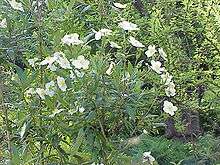Carpenteria
| Carpenteria californica | |
|---|---|
 | |
| Scientific classification | |
| Kingdom: | Plantae |
| (unranked): | Angiosperms |
| (unranked): | Eudicots |
| (unranked): | Asterids |
| Order: | Cornales |
| Family: | Hydrangeaceae |
| Genus: | Carpenteria |
| Species: | C. californica |
| Binomial name | |
| Carpenteria californica Torr. | |
Carpenteria californica /ˌkɑːrpənˈtɪəriə ˌkælᵻˈfɔːrnᵻkə/,[1] the sole species in the genus Carpenteria, with the common names tree anemone and bush anemone.
It is a flowering evergreen shrub native to the Sierra Nevada foothills in California. It is closely related to the genus Philadelphus.
._SDNHM_ARV_1933-0493.jpg)
Distribution
It is a rare species, endemic to only seven sites in Fresno and Madera Counties, where it grows in chaparral and oak woodlands between 340–1,340 m (1,115–4,396 ft) altitude in the Sierra Nevada, between the San Joaquin River and Kings River. It is well adapted to wildfire, reproducing by stump sprouts after burning. Natural seedlings are rare.
Description
Carpenteria californica grows to 1–3 m (3 ft 3 in–9 ft 10 in) tall, with flaky bark on older stems. The leaves are opposite, lanceolate, 4–10 cm long and 1-2.5 cm broad, glossy green above, blue-green to whitish and downy beneath.
The flowers are 3–7 cm diameter, with 5-8 pure white petals and a cluster of yellow stamens; flowering is from late spring to mid summer. The fruit is a leathery capsule 6–12 mm diameter, containing numerous seeds.
Cultivation
Carpenteria californica is cultivated as an ornamental plant, grown for its lush appearing foliage, seasonal flowers and drought tolerance. It is used in traditional, native plant, and wildlife gardens in California and other Mediterranean climates, and in colder locations. [2] [3]
It has been in cultivation since 1875, and is now much more common in gardens than in its natural habitat. It first flowered in England for Gertrude Jekyll at Godalming in 1885.[3] The species has gained the Royal Horticultural Society's Award of Garden Merit.[4]
Cultivars include:
- Carpenteria californica 'Bodnant' — cold-tolerant cultivar, hardy to −15 °C (5 °F) in the British Isles.
- Carpenteria californica 'Elizabeth' — masses of smaller white flowers, more compact growth habit. [5]
- Carpenteria californica 'Ladham's' — large flowers.
History
The genus was named in honor of Dr. William Marbury Carpenter,[6] a noted botanist from Louisiana.
Note that Carpenteria should not be confused with the similarly spelled Carpentaria, a genus of palms native to northern Australia.
See also
- California interior chaparral and woodlands — plant community.
- List of plants of the Sierra Nevada (U.S.)
- Natural history of the California chaparral and woodlands
References
- ↑ Sunset Western Garden Book, 1995:606–607
- ↑ NPIN−Lady Bird Johnson Wildflower Center: Carpenteria californica
- 1 2 Western Horticultural Society: Carpenteria californica
- ↑ http://apps.rhs.org.uk/plantselector/plant?plantid=332
- ↑ San Marcos Growers horticulture database: Carpenteria californica 'Elizabeth'
- ↑ Glenn R. Conrad, ed.: A Dictionary of Louisiana Biography, Vol. I, A to M, The Louisiana Historical Association, New Orleans, La., 1988, pp. 24, 153-154, 303. 557.
External links
- Carpenteria californica (bush anemone, tree anemone)
- Jepson Manual eFlora (TJM2) treatment of Carpenteria californica
- California Native Plant Society: Carpenteria
- USDA Plants Profile for Carpenteria californica (tree anemone)
- UC CalPhotos gallery: Carpenteria californica
| Wikimedia Commons has media related to Carpenteria californica. |